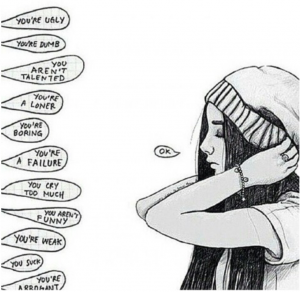Parents Guide to Bullying
4. Parents and Other Adults
Parents Guide to Bullying
To act with confidence it helps parents (and other adults) to have a simple “parents guide to bullying.” There are a few key points to understand and things to do – and they make a big difference.
Spotting the Signs of Bullying
Bullying can be hard to see. In high school, the bullying is often less physical. Also, your teenager might try to hide the bullying from you and others. Most teenagers aren’t going to come home and tell you that they’re being bullied. They might feel ashamed and afraid or they might not want you to worry or make a big deal – or perhaps make it worse. Often teenagers just want bullying to go away without drawing attention to it.
What are the signs you need to know as a parent? There are a number of signs to look for if you suspect bullying. One word of caution: exhibiting one or more of these signs might not necessarily mean that your son or daughter is being bullied. Your teenager might be experiencing some of these signs for other reasons, so it’s best to talk. Don’t assume bullying – but don’t ignore it either. It’s best to talk to get the truth.
School Problems
- Loss of interest in classes or school activities
- Unhappy or anxious before or after school
- Reluctant to go to school or to get on the computer.
- Not wanting to get on the school bus; begs you for rides to school every day.
- Doesn’t seem to be eating his lunch
- Decrease in school performance
Emotional Signs
- He or she becomes more and more isolated from others
- She or he shows noticeable changes in behavior or emotions, like withdrawal, anger, depression, aggressive behavior, anxiety
- He or she has trouble sleeping
- She or he seems low on self-confidence.
Physical Signs
- Physical injuries he or she can’t or won’t explain – for example, bruises or torn clothing
- Coming home with damaged or missing belongings or money
- Significant or rapid weight loss or gain
- New nervous habits
- Is frequently sick, with headaches, stomach ache and sleeping problems—and often wants to stay home from school.
- Disconnecting from home or isolating self from peers
- Changes in appetite
- Self-destructive behaviors or thoughts – self harm and suicidal thoughts
- Running away from home
- Explosive moodiness beyond normal pubescent behavior
Specific Cyber Signs
- He or she suddenly stops using the computer or cell phone. The National Crime Prevention Council calls this the biggest red flag.
- She or he appears upset after using the computer or receiving calls or texts.
- He or she is secretive about what they are doing online or with their cell phone.

Partnering With Your Teenager to Combat Bullying
Parents, school staff, and other caring adults have a critical role to play in preventing and combatting bullying. Partnering with your teenager may take a good deal of sensitivity, perseverance, flexibility, and resilience because it’s a tough challenge and there is no simple answer. However, it’s worth the effort because adult involvement is absolutely critical.
There are a number of actions you can weave together to make a difference:
#1 Affirm their courage when they ask for help. Most teenagers don’t tell their parents about bullying on or offline. So, if they do take the risk to ask for help, let them know that you admire their courage and their willingness to stand up for themselves.
#2 Communicate openly. You can ask about bullying in their school, neighborhood or online. You can also check in if you see signs of bullying. You can encourage your teenager to talk with other trusted adults and possibly enable such conversations (if they are having trouble with it).
You can also talk with other parents and school personnel to understand what is going on around you. At appropriate times you can also share any experiences you have had with bullies.
#3 Increase the love, attention, and support that you show. That does not mean treating them as a victim that you need to save. It does mean acknowledging that they are under pressure or duress and could use support – and that you might err in the direction of overdoing it. You are loving them for who they are – not for what they are not – and are supporting them in dealing with one of lives more painful challenges.
This also means ensuring that they know that they are not to blame and that the bullying will not last forever – because you will deal with it together.
#4 Respond calmly and thoughtfully, not rashly or out of fear or anxiety. Parents can make things worse for their teenager if they overreact. In a crisis you may need to act swiftly or boldly, but even then bringing a sense of thoughtfulness and confidence is key. You can lose your son’s or daughter’s trust if you act rashly – and can precipitate an increase in the bullying. The power that you can bring to bear in a calm, thoughtful, confident manner is the kind that makes you easier to partner with and gives you more influence over outcomes. That doesn’t mean that you will know exactly what to do, but that you will figure it out – together.

#5 Listen – “seek first to understand, then to act.” What helps targets of bullying the most initially is simply to feel heard – by a friend, parent, or other trusted adult. That communicates the caring, forms the connection and common ground, and opens the door to finding solutions together.
Listening creates a safe space into which your daughter or son can step. It also ensures that you have as accurate a picture of their experience as possible. It can, however, take significant discipline to hold off on focusing on solutions in order to listen effectively. Listening and reflecting can lead to better and more collaborative solutions – and prevent impulsive or overly emotional reactions that can be regretted.
#6 Be a partner, not a savior. Assure you son or daughter that you will not just run off on your own to “save” them. Let them know that you will partner with them. A major reason to not “take over” is that your teenager has just had their power taken away from them by the bully. You don’t want to do the same thing, even when being well-meaning. The task is to build and exert power and influence in a shared collaborative fashion. The heart of the teen heroic journey is becoming the author of a life, so even something as hurtful as bullying can be used to develop that authorship.

The collaboration process in a partnership approach can take more time than unilateral actions, but it usually results in better results that can be implemented more effectively. Plus, the process itself can be healing and empowering. It can take several sit-downs to come up the desired plan for countering the bullying and recovering from it, but each sit down is a chance to come together and it will add to the value of the actual plan of action.
A key aspect of the partnership will be coming together to “see how are we doing” in implementing the actions in the plan. All plans are starting points and paying attention to experience as they are implemented is how they are refined and end up working.
#7 Project ahead and rehearse. This can be surprisingly important. Thinking ahead about how different actions might play out can build confidence as well as help refine what you want to do. It’s like practicing or rehearsing for a game or performance. You can also practice for what to do if the actions don’t work as hoped because things don’t always work as planned.
#8 Don’t let the bullying dominate life – focus on growth. This can be tough, but it’s important to take back power by focusing on the positive aspects of life and putting time, attention, and energy into productive areas. You can focus on favorite activities, hobbies, trips, upcoming events, etc. This is not just “trying to make it all better.” It’s not allowing the bullying to control life.
You can also keep the attention on building strength by supporting a focus on the three core challenges of being a teenager – establishing an identity as a young adult, developing more mature relationships and building the competencies of a young adult (all addressed on this site). Those are all long-term challenges (it’s a 10-year journey), but significant steps can be taken in all three areas.
Dignity, self-worth, resilience, and the ability to meet life’s challenges can all develop when dealing with bullying. The bullies won’t be developing, but the targets of the bullying can grow dramatically.
#9 Involve others as appropriate. This can range from engaging school personnel, police, attorneys, and internet service providers to other teenagers, trusted adults or organizations dealing with bullying. Bullies lose much of their power and motivation when confronted by a signifiant number of people standing up to them. Sometimes you need people authority to be involved. Sometimes it’s a matter of getting as many upstanders involved as possible.
#10 Model the behavior you want to see in your teenager. There are a lot of possibilities here. You can model understanding and toughness. You can model caring and compassion. You can also model courage and perseverance. And you can model accepting a person, but not their behavior. You can also model how to stand up for others and how to collaborate with others to get things done. The list of possibilities is extensive – and your teenager will not miss the messages you communicate through your modeling of desired behavior.
